Rosetta - the most interesting space mission of 2014
In 2014, there will be two exciting events in the Solar System that are worth the wait. Ironically, they are both associated with comets. Today I will talk about one of them.

This summer and autumn in space will be the culmination of one of the most interesting research operations, comparable in importance to the landing of the Curiosity rover - the implementation of the long-term Rosetta program. This spacecraft was launched in 2004 and flew for ten long years in the inner solar system, making adjustments and gravitational maneuvers, only to go into the orbit of the comet (67P) Churyumov-Gerasimenko. Rosetta should overtake the comet, how to study from a distance, and land the descent vehicle Philae. He will conduct his part of the research and together they will tell us about comets as much as possible in a robotic mission.
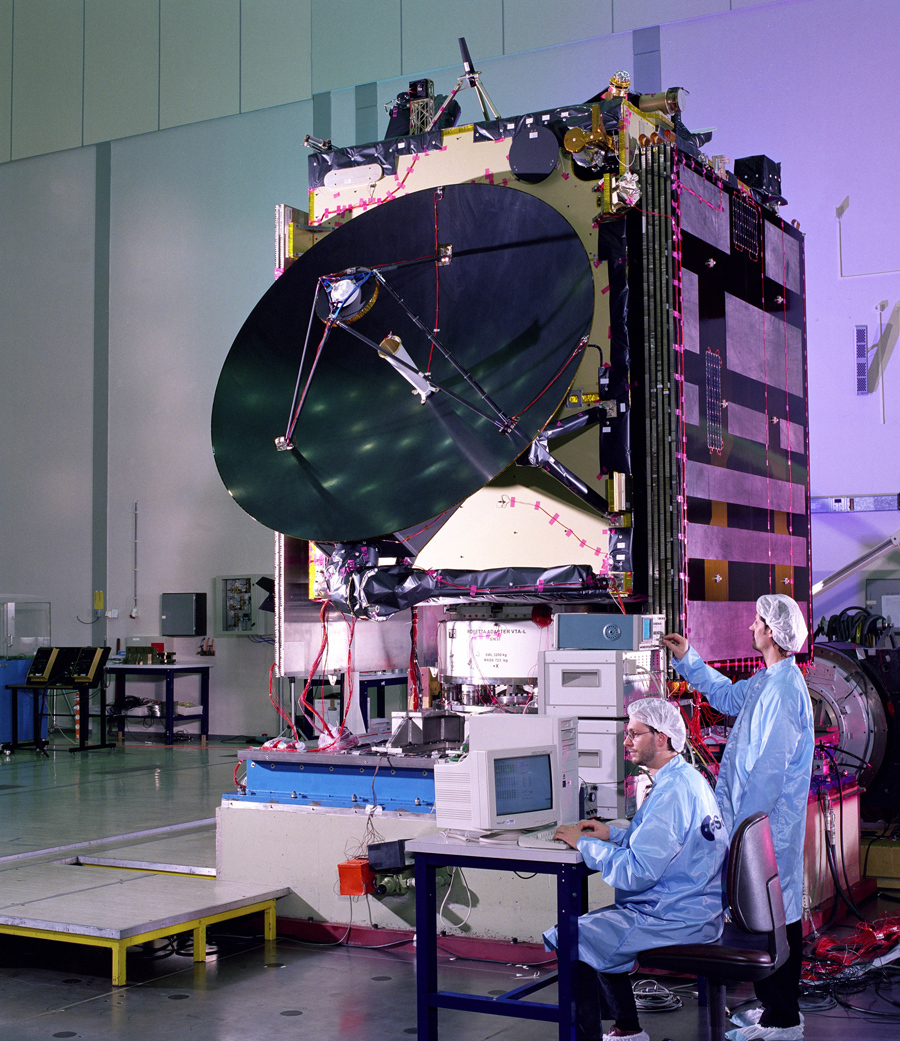
Great photo
')
Comet Churyumov-Gerasimenko is not some unique cosmic body that requires mandatory study. On the contrary, it is an ordinary short-period comet, returning to the Sun, every 6.6 years. It does not fly beyond the orbit of Jupiter, but its trajectory is predictable, and successfully turned up to the launch window of the spacecraft. Rosetta had previously planned for another comet, but problems with the launch vehicle forced to postpone the launch, so the goal has changed.
A curious question - why did the comet have to fly for ten years, if it arrives more often? The reason for this is the scientific program Rosetta. All previous missions, starting with the American-European ICE and the Soviet “Vega” in the 80s, and ending with Stardust in 2011, took place on a collision course or flight path. For thirty years, scientists have been able to photograph near the cometary nucleus; able to throw a metal blank on the comet, and after a few years look at the result of the fall; could even bring to Earth some cometary dust from the tail. But to spend time with a comet's core for quite a long time, and to sit on it, a simple meeting is not enough. The speed of comets can reach dozens and even hundreds of kilometers per second, to which the second spacecraft of the apparatus itself is added, therefore you can only bomb the Bruce Willis or “land” the comet.
The long journey allowed Rosetta to get close to the comet from behind and to settle in next, following the same speed and course as (67P) Churyumov-Gerasimenko.
Along the way, beautiful views of the Earth were shot:

Great photo .
On board the three-tonne spacecraft there are 12 scientific instruments that will allow to study the temperature, composition, evaporation rate of the cometary tail, the surface of the nucleus. The radar experiment will allow the radar ultrasound to be made to the cometary nucleus in order to determine its internal structure. But the most interesting, from the point of view of the spectacularity of the “picture”, are the results from the optical camera OSIRIS (Optical, Spectroscopic, and Infrared Remote Imaging System). This is a dual photo device equipped with two cameras with 700 mm and 140 mm lenses and CCD matrices of 2048x2048 pixels.
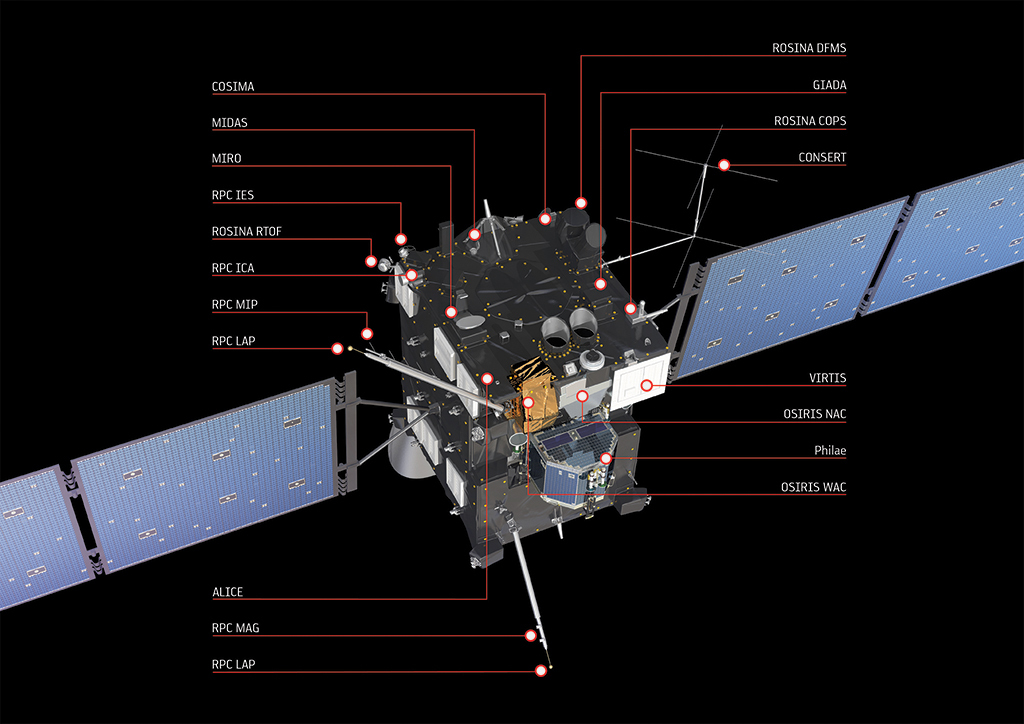
During the time that Rosetta spent on the road, she did not idle, but implemented a research program worthy of several independent missions. In general, she demonstrates an example of how useful it is to have a spacecraft with a long-range camera darting back and forth around the solar system.
A year and a half after the launch, she looked from afar at the implementation of the NASA Deep Impact mission. Impactor's blow to the comet Tempel 1 caused a flash that is difficult to see with the eyes:

but it was registered by more sensitive sensors:

Two years later, Rosetta flew at close range from Mars and made simply chic pictures of the planet in different spectral ranges. In optical mars it looks like this:
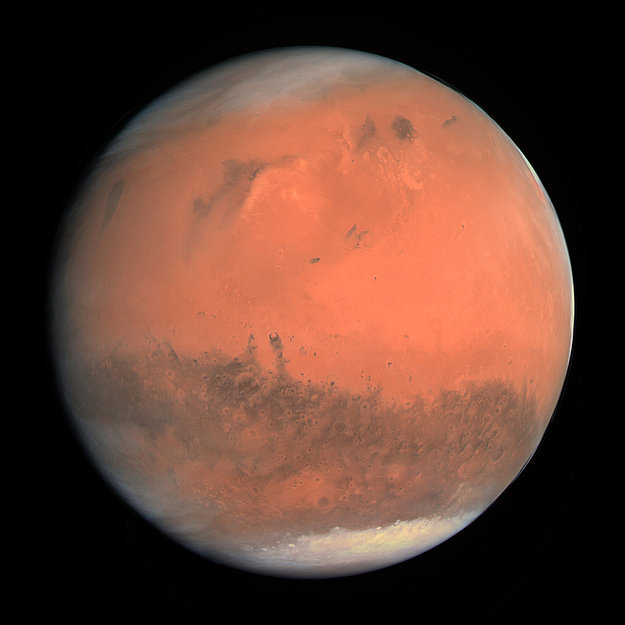
And the UV channel allowed us to highlight the details in the Martian atmosphere:

We managed to make a separate photo with the Philae onboard camera:
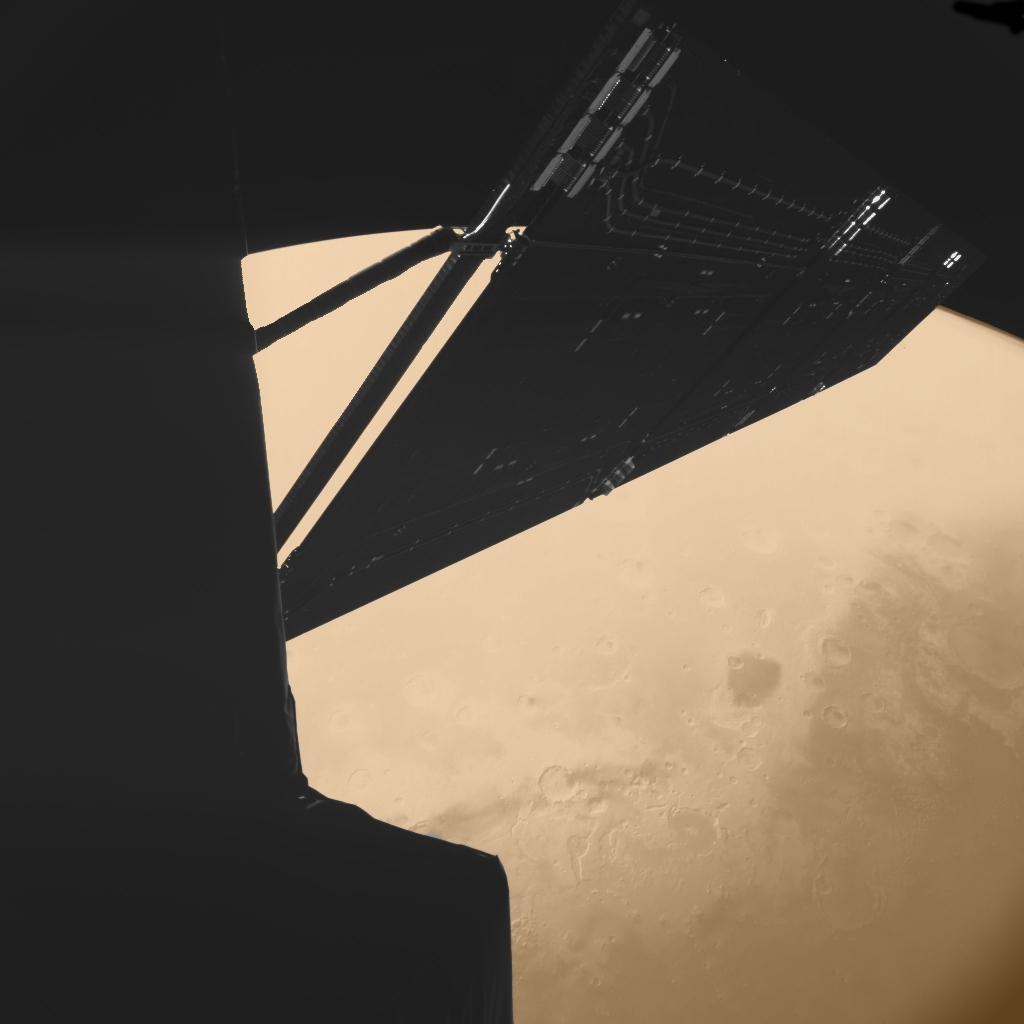
It is curious that, depending on the camera, the color of the observed surface may vary significantly. This pale-beige color of Mars was given by the satellite camera Mars Global Surveyor. (As it turned out , the color is added artificially).
After Mars, Rosetta “fell asleep” to wake up in a year and a half in 2008, to shoot a six-kilometer-long asteroid Steins flying at a distance of 800 km. True, the system failure prevented the asteroid from taking pictures with a long-range camera, but the wide-angle allowed to take pictures with details up to 80 meters per pixel and obtain valuable data about the object.

Even from Earth, it was determined that the asteroid belongs to the class-E. Inspection at close range confirmed this. It turned out that Steins is composed of silicates, poor in iron, but rich in magnesium, while some minerals suffered heating of more than 1000 degrees Celsius. Observations of the surface and features of the asteroid's rotation could confirm in practice the YORP effect. This effect occurs (more clearly manifested more noticeably) in small asteroids of irregular shape. Uneven heating of the surface leads to the fact that the infrared radiation of the heated part creates a jet thrust, which increases the speed of rotation of the asteroid.
It is curious that, based on the theory of the YORP effect, Steins should have had the shape of a double cone, but the large impact crater at the south pole “flattened” the asteroid and gave it the shape of a “diamond”. The same blow seems to have split the cosmic body in half, but it continues to hold on to the forces of gravity, although scientists have considered signs of a giant crack cutting through Steins.
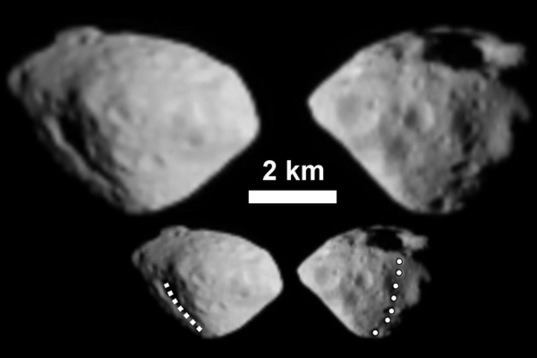
In the spring of 2010, Rosetta made it possible to better identify the comet-like body P / 2010 A2 found in the asteroid belt. This “comet” made a noise in the camp of astronomers in 2010, when it began to behave completely uncommitted.
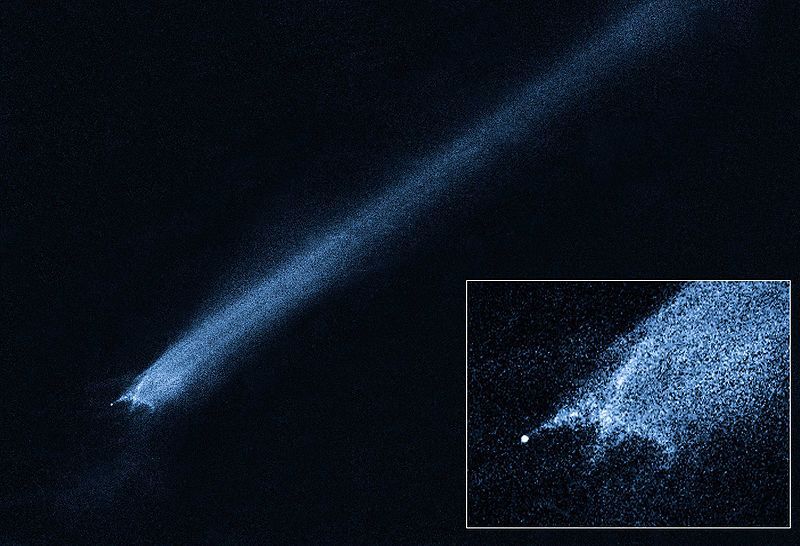
Hubble telescope shot.
Despite the fact that the Rosetta camera cannot be compared with Hubble, observations from a different angle made it possible to determine that it was not a comet, but the result of a space accident, when a small chip about a meter in size crashed into a 150 meter asteroid.
But the asteroid "star" of 2010 was (21) Lutetia. This is a hundred-kilometer asteroid that Rosetta inspected, from a distance of 3170 km. This time the 700 mm camera worked perfectly, so even from that distance it turned out to remove the surface details up to 60 m per pixel.
Lutetia is a very interesting and mysterious object, the study of which has caused many questions. Earlier, astronomers from Earth identified its spectral class as M - asteroids with a large number of metals, whereas the spectral studies of Rosetta indicated rather class C - carbonaceous chondrites. The surface photographs made it possible to conclude that Lutetia is covered for 3 km with a thick carpet of shattered regolith hiding the bedrock. An analysis of the mass made it possible to determine its density: higher than that of stone, but lower than that of metal asteroids, which also led to confusion. As a result, scientists have decided that we are facing one of the few remaining planetesimals from the moment of the birth of the Solar System, the “embryos of planets”.
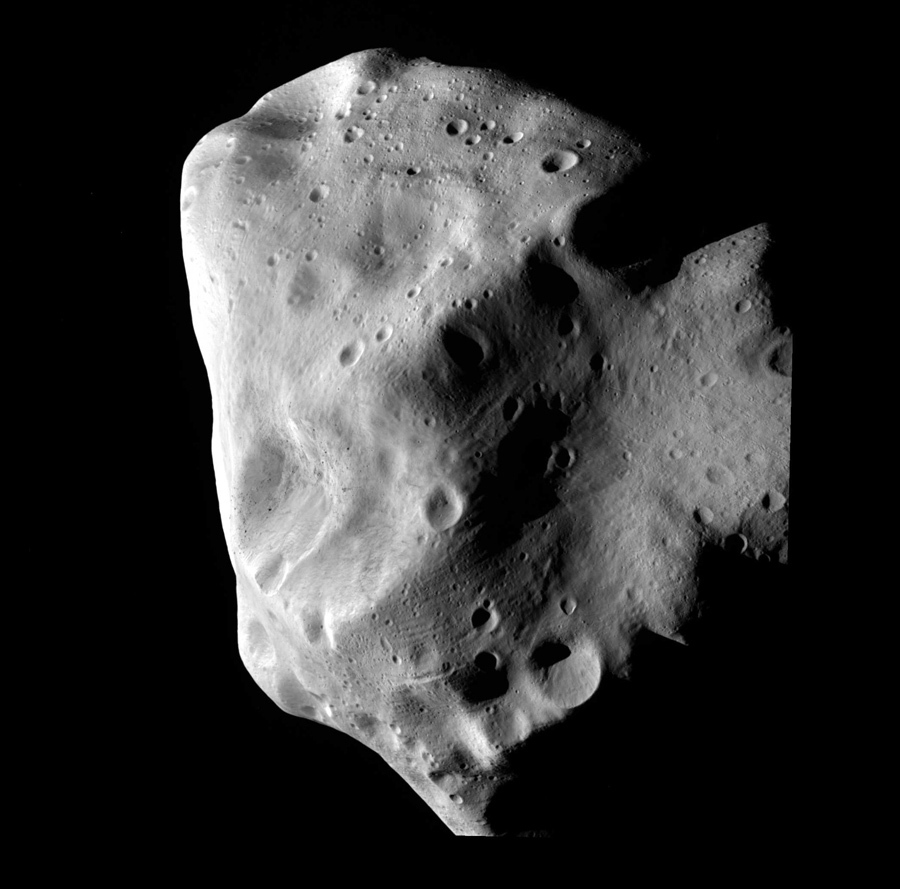
Great photo .
Once Lutetia began the process of differentiation of substances, moving heavy metal rocks to the center and moving light stone to the surface. However, it turned out to be too far from the orbits of the formation of the stone planets of the Solar System and too close to Jupiter, whose gravitational perturbations did not allow to gain the necessary mass. Moreover, it is believed that earlier the Lutetia form was approaching the sphere, but multiple collisions in the asteroid belt over 3.5 billion years disfigured its appearance.
After inspecting Lutetia, Rosetta fell asleep again to wake up only on January 20, 2014. Now the equipment is being checked and no malfunctions have been revealed, which seems to be a fantastic result, for the spacecraft having spent ten years in open space and flying twice through the asteroid belt.
What lies ahead? Make notes in the calendar.
May 2014: Another important moment for the mission is the latest corrections of the trajectory for convergence with the comet. At the end of May, the distance between the “hunter and the victim” will be about 100 thousand km. I think by that time the first pictures of the comet and its nucleus will begin to arrive. To Earth from them will be another 450 million kilometers, so watching the comet alone will turn out only in powerful telescopes.
August 2014: Rosetta enters the comet. Of course while in whom. It is believed that particles of dust and ice coma can damage the spacecraft, but this is in the case of opposite trajectories. For Rosetta, the speed of the comet will be almost zero, so no serious damage is expected. But these days the most spectacular images of the approaching and rotating cometary nucleus are expected. If the cameras work normally, we will be able to see not only the surface of the nucleus, but also the processes that take place on it, as it approaches the Sun. Gas and dust jets, beating from the depths, should look just gorgeous.
November 2014: the most intense days, hours, minutes. A close approach with a comet of up to 3 km occurs and the descent vehicle Philae is reset. He must land on the core, drill it, take a picture, enlighten with a radar, take soil samples ... In short, if the mission is successful, it will be a real triumph of interplanetary science.

2015: Rosetta will continue to follow with the comet as long as it can. The durability of Philae is questionable, much depends on the landing site, the mode of rotation of the core, and the conditions on the surface. During rapprochement with the Sun, it should have enough energy to work, but, as it moves away, the efficiency of the batteries will fall. If you can sit down and stretch at least a month - this will already be a gift for the creators and for dozens of European and US scientists.
Unfortunately, it will be almost impossible to observe a comet from Earth without serious technology. Therefore, we can only wait, follow the news, and wish good luck to the European Space Agency. Fly, Rosetta! Fly!

This summer and autumn in space will be the culmination of one of the most interesting research operations, comparable in importance to the landing of the Curiosity rover - the implementation of the long-term Rosetta program. This spacecraft was launched in 2004 and flew for ten long years in the inner solar system, making adjustments and gravitational maneuvers, only to go into the orbit of the comet (67P) Churyumov-Gerasimenko. Rosetta should overtake the comet, how to study from a distance, and land the descent vehicle Philae. He will conduct his part of the research and together they will tell us about comets as much as possible in a robotic mission.

Great photo
')
Comet Churyumov-Gerasimenko is not some unique cosmic body that requires mandatory study. On the contrary, it is an ordinary short-period comet, returning to the Sun, every 6.6 years. It does not fly beyond the orbit of Jupiter, but its trajectory is predictable, and successfully turned up to the launch window of the spacecraft. Rosetta had previously planned for another comet, but problems with the launch vehicle forced to postpone the launch, so the goal has changed.
A curious question - why did the comet have to fly for ten years, if it arrives more often? The reason for this is the scientific program Rosetta. All previous missions, starting with the American-European ICE and the Soviet “Vega” in the 80s, and ending with Stardust in 2011, took place on a collision course or flight path. For thirty years, scientists have been able to photograph near the cometary nucleus; able to throw a metal blank on the comet, and after a few years look at the result of the fall; could even bring to Earth some cometary dust from the tail. But to spend time with a comet's core for quite a long time, and to sit on it, a simple meeting is not enough. The speed of comets can reach dozens and even hundreds of kilometers per second, to which the second spacecraft of the apparatus itself is added, therefore you can only bomb the Bruce Willis or “land” the comet.
The long journey allowed Rosetta to get close to the comet from behind and to settle in next, following the same speed and course as (67P) Churyumov-Gerasimenko.
Along the way, beautiful views of the Earth were shot:

Great photo .
On board the three-tonne spacecraft there are 12 scientific instruments that will allow to study the temperature, composition, evaporation rate of the cometary tail, the surface of the nucleus. The radar experiment will allow the radar ultrasound to be made to the cometary nucleus in order to determine its internal structure. But the most interesting, from the point of view of the spectacularity of the “picture”, are the results from the optical camera OSIRIS (Optical, Spectroscopic, and Infrared Remote Imaging System). This is a dual photo device equipped with two cameras with 700 mm and 140 mm lenses and CCD matrices of 2048x2048 pixels.

During the time that Rosetta spent on the road, she did not idle, but implemented a research program worthy of several independent missions. In general, she demonstrates an example of how useful it is to have a spacecraft with a long-range camera darting back and forth around the solar system.
A year and a half after the launch, she looked from afar at the implementation of the NASA Deep Impact mission. Impactor's blow to the comet Tempel 1 caused a flash that is difficult to see with the eyes:

but it was registered by more sensitive sensors:

Two years later, Rosetta flew at close range from Mars and made simply chic pictures of the planet in different spectral ranges. In optical mars it looks like this:

And the UV channel allowed us to highlight the details in the Martian atmosphere:

We managed to make a separate photo with the Philae onboard camera:

It is curious that, depending on the camera, the color of the observed surface may vary significantly. This pale-beige color of Mars was given by the satellite camera Mars Global Surveyor. (As it turned out , the color is added artificially).
After Mars, Rosetta “fell asleep” to wake up in a year and a half in 2008, to shoot a six-kilometer-long asteroid Steins flying at a distance of 800 km. True, the system failure prevented the asteroid from taking pictures with a long-range camera, but the wide-angle allowed to take pictures with details up to 80 meters per pixel and obtain valuable data about the object.

Even from Earth, it was determined that the asteroid belongs to the class-E. Inspection at close range confirmed this. It turned out that Steins is composed of silicates, poor in iron, but rich in magnesium, while some minerals suffered heating of more than 1000 degrees Celsius. Observations of the surface and features of the asteroid's rotation could confirm in practice the YORP effect. This effect occurs (more clearly manifested more noticeably) in small asteroids of irregular shape. Uneven heating of the surface leads to the fact that the infrared radiation of the heated part creates a jet thrust, which increases the speed of rotation of the asteroid.
It is curious that, based on the theory of the YORP effect, Steins should have had the shape of a double cone, but the large impact crater at the south pole “flattened” the asteroid and gave it the shape of a “diamond”. The same blow seems to have split the cosmic body in half, but it continues to hold on to the forces of gravity, although scientists have considered signs of a giant crack cutting through Steins.

In the spring of 2010, Rosetta made it possible to better identify the comet-like body P / 2010 A2 found in the asteroid belt. This “comet” made a noise in the camp of astronomers in 2010, when it began to behave completely uncommitted.

Hubble telescope shot.
Despite the fact that the Rosetta camera cannot be compared with Hubble, observations from a different angle made it possible to determine that it was not a comet, but the result of a space accident, when a small chip about a meter in size crashed into a 150 meter asteroid.
But the asteroid "star" of 2010 was (21) Lutetia. This is a hundred-kilometer asteroid that Rosetta inspected, from a distance of 3170 km. This time the 700 mm camera worked perfectly, so even from that distance it turned out to remove the surface details up to 60 m per pixel.
Lutetia is a very interesting and mysterious object, the study of which has caused many questions. Earlier, astronomers from Earth identified its spectral class as M - asteroids with a large number of metals, whereas the spectral studies of Rosetta indicated rather class C - carbonaceous chondrites. The surface photographs made it possible to conclude that Lutetia is covered for 3 km with a thick carpet of shattered regolith hiding the bedrock. An analysis of the mass made it possible to determine its density: higher than that of stone, but lower than that of metal asteroids, which also led to confusion. As a result, scientists have decided that we are facing one of the few remaining planetesimals from the moment of the birth of the Solar System, the “embryos of planets”.

Great photo .
Once Lutetia began the process of differentiation of substances, moving heavy metal rocks to the center and moving light stone to the surface. However, it turned out to be too far from the orbits of the formation of the stone planets of the Solar System and too close to Jupiter, whose gravitational perturbations did not allow to gain the necessary mass. Moreover, it is believed that earlier the Lutetia form was approaching the sphere, but multiple collisions in the asteroid belt over 3.5 billion years disfigured its appearance.
After inspecting Lutetia, Rosetta fell asleep again to wake up only on January 20, 2014. Now the equipment is being checked and no malfunctions have been revealed, which seems to be a fantastic result, for the spacecraft having spent ten years in open space and flying twice through the asteroid belt.
What lies ahead? Make notes in the calendar.
May 2014: Another important moment for the mission is the latest corrections of the trajectory for convergence with the comet. At the end of May, the distance between the “hunter and the victim” will be about 100 thousand km. I think by that time the first pictures of the comet and its nucleus will begin to arrive. To Earth from them will be another 450 million kilometers, so watching the comet alone will turn out only in powerful telescopes.
August 2014: Rosetta enters the comet. Of course while in whom. It is believed that particles of dust and ice coma can damage the spacecraft, but this is in the case of opposite trajectories. For Rosetta, the speed of the comet will be almost zero, so no serious damage is expected. But these days the most spectacular images of the approaching and rotating cometary nucleus are expected. If the cameras work normally, we will be able to see not only the surface of the nucleus, but also the processes that take place on it, as it approaches the Sun. Gas and dust jets, beating from the depths, should look just gorgeous.
November 2014: the most intense days, hours, minutes. A close approach with a comet of up to 3 km occurs and the descent vehicle Philae is reset. He must land on the core, drill it, take a picture, enlighten with a radar, take soil samples ... In short, if the mission is successful, it will be a real triumph of interplanetary science.

2015: Rosetta will continue to follow with the comet as long as it can. The durability of Philae is questionable, much depends on the landing site, the mode of rotation of the core, and the conditions on the surface. During rapprochement with the Sun, it should have enough energy to work, but, as it moves away, the efficiency of the batteries will fall. If you can sit down and stretch at least a month - this will already be a gift for the creators and for dozens of European and US scientists.
Unfortunately, it will be almost impossible to observe a comet from Earth without serious technology. Therefore, we can only wait, follow the news, and wish good luck to the European Space Agency. Fly, Rosetta! Fly!
Source: https://habr.com/ru/post/211444/
All Articles